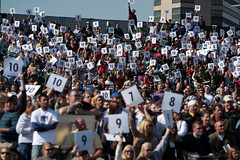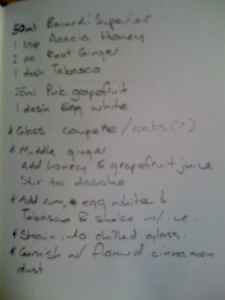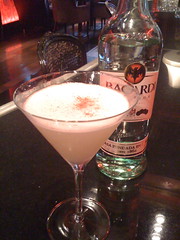Workshop, pt. 6: regionals
 Today was my regional heat for the Bacardi Legacy competition. Regionals can take many forms and today's format was another new experience.
For the purposes of the competition, the UK was split into seven regions. More than two hundred entries were whittled down to seventy (ten per region, but I'm guessing on that), with only one entry from each region progressing to the national final in February.
Today was my regional heat for the Bacardi Legacy competition. Regionals can take many forms and today's format was another new experience.
For the purposes of the competition, the UK was split into seven regions. More than two hundred entries were whittled down to seventy (ten per region, but I'm guessing on that), with only one entry from each region progressing to the national final in February.
So, statistically speaking, a 1 in 10 chance of making nationals. But, cocktail comps aren't decided out of a hat, so my odds just lengthened. Given I don't know who else qualified from my region (which, let's face it, is going to be one of the hardest to get out of if the likes of Mal Spence submitted entries; I'm also hoping that all the Scotland-based bartenders who have recipes in the 2008 Legacy Book aren't getting another go) and that adjustment might have to be in orders of magnitude.
 A lot of competitions involve making your drink in front of your direct rivals as well as the judges, unless it's judged on a blind tasting, in which case your audience will largely comprise people who want to beat you. The interesting thing about the Legacy regional heat was that it was conducted by two judges in your bar, without spectators, without other competitors. It made for a refreshing change. That's not to say that the format's without it challenges. One of the judges who was assessing me spoke of a bartender in Belfast who had made his presentation while still serving paying customers and making service checks because his replacement was running late.
A lot of competitions involve making your drink in front of your direct rivals as well as the judges, unless it's judged on a blind tasting, in which case your audience will largely comprise people who want to beat you. The interesting thing about the Legacy regional heat was that it was conducted by two judges in your bar, without spectators, without other competitors. It made for a refreshing change. That's not to say that the format's without it challenges. One of the judges who was assessing me spoke of a bartender in Belfast who had made his presentation while still serving paying customers and making service checks because his replacement was running late.
The format allowed me to focus on my presentation and my drink, which isn't always the case if I get starstruck or rattled by the guys I'm up against. It shouldn't happen, but it does. At any rate, the national final is set to be a more traditional competition format, so there's that bridge to cross. Or not.
(Judges Score photo from CraigOppy's photostream on Flickr.)


